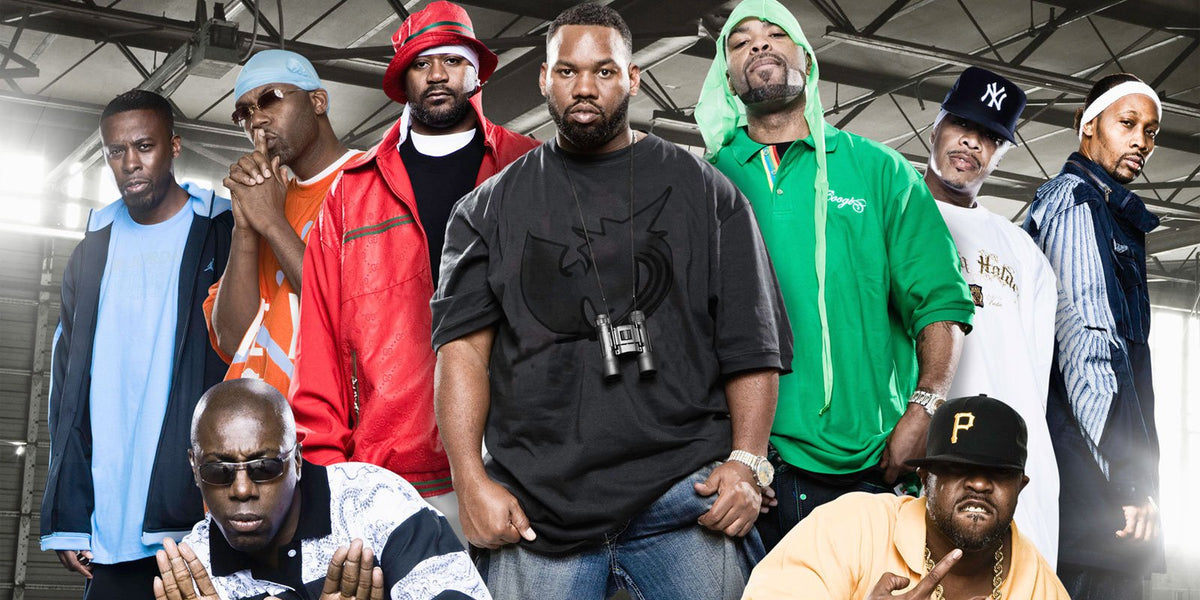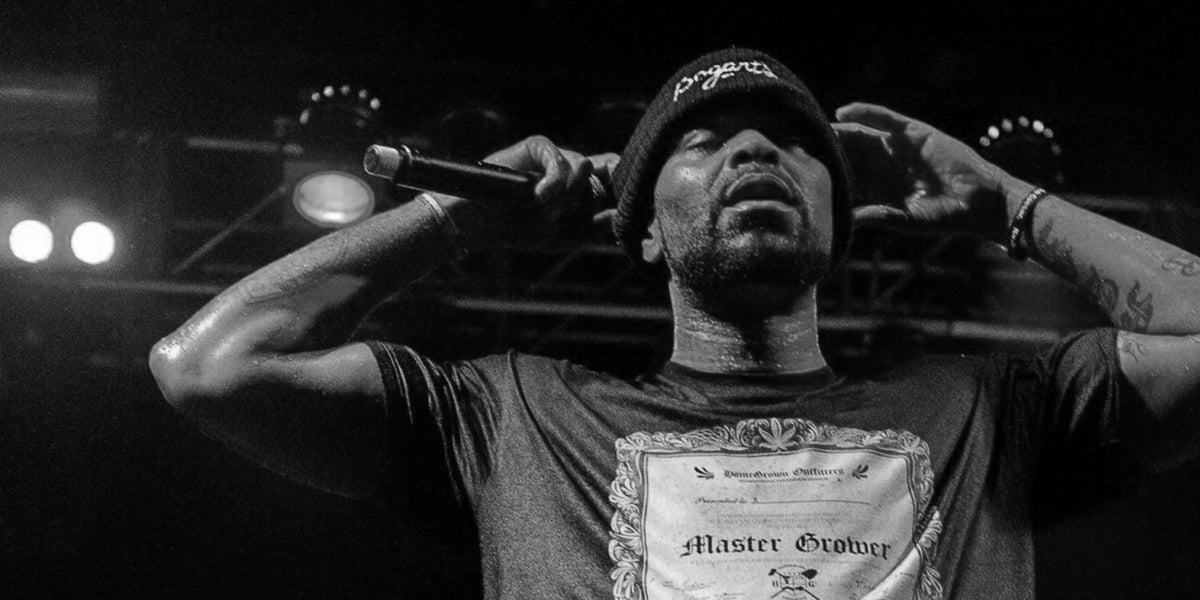Wu-Tang Clan’s Meteoric Rise from the Underground
How ‘Enter the Wu-Tang (36 Chambers)’ Launched the Group into Global Stardom
“Shaolin shadowboxing and the Wu-Tang sword style.”
The iconic line is ubiquitous with 1983 revenge kung-fu film Shaolin and Wu-Tang and the opener of Wu-Tang Clan’s 1993 genre-shifting rap album Enter the Wu-Tang (36 Chambers). While late-’80s East Coast rap was brimming with Afrocentrism through the Native Tongues collective and the quintessential B-boy flair of Run-DMC, Wu-Tang Clan rose from the ether as a minatory, philosophical force hailing from Staten Island. Although 36 Chambers was just a decade apart from Shaolin and Wu-Tang, the cross-cultural impact of Wu-Tang Clan resounded through martial arts film samplings and homage to the Five Percenter teachings that ran rampant on New York hip-hop and mainstream airwaves alike.
Before Wu-Tang’s ascension, they were All In Together Now (doubling as Force of the Imperial Master), a trio of budding rap icons including superproducer polymath Prince Rakeem (“The Scientist”), audacious, drunken rapper Ason Unique (“The Specialist”) and ornate emcee The Genius. The three were cousins, led by Rakeem after his 1991 EP Ooh I Love You Rakeem hit a flatline on Tommy Boy Records, while The Genius was scrapped from Cold Chillin’ Records when the label failed to promote his fellow 1991 debut album Words from the Genius. On one hand, both artists were simultaneously dropped from their respective labels, but on the other, a fire was ignited. Feeling deceived as label executives opted for clean-cut and white rappers — Tommy Boy Records turned their attention from Prince Rakeem to West Coast enclave House of Pain — Rakeem and The Genius assembled, convincing Unique to get on board.
In 1992, with a keen eye for vintage grindhouse kung-fu films, Eastern philosophy, chess, Five Percenter ideologies and Supreme Mathematics, Rakeem, Unique and The Genius soldiered the streets of Shaolin for new emcee recruits. As the mastermind of Wu-Tang, Prince Rakeem instinctively selected five additional members that would become uncontested marksmen in hip-hop. With their power-in-numbers strategy, a new legion of emcees surfaced from the arsenal of Staten Island: Ghostface Killah, Inspectah Deck, Method Man, Raekwon the Chef and U-God (Masta Killa, the group’s ninth member, joined last). Remerging with new monikers, the lyrical and production technique remained as Rakeem became RZA, The Genius morphed into GZA and Unique emanated as Ol’ Dirty Bastard.
In an Enter the Wu-Tang (36 Chambers) 25th anniversary tribute for DJBooth published in 2018, journalist Matt Wilhite describes the group’s transformation precisely:
“The group was comprised of a potential star in Method Man, dedicated marksmen in Inspectah Deck and GZA, an unhinged tour de force in Ol’ Dirty Bastard, mafioso stylists in Ghostface Killah and Raekwon, a rap newcomer in Masta Killa, and an MC in legal troubles with U-God. RZA wanted to merge the skill and power that each of these MCs possessed and turn the frenzied style that they had created together into something trained and masterful. A swarm moving in unison, but each bee with its own particular stinger.”
The “Killa Beez” that fraternized became Wu-Tang Clan, a salute to ancient East Asian fighting styles and religion, but doubled as various acronyms such as “Wise Universal Truth Allah Now God,” “Witty Unpredictable Talent and Natural Game” and “We Usually Take All Niggas’ Garments.” Their approach was tactical and gritty, retelling the grimness of their Staten Island upbringing while energetically paralleling their genesis to dominance of Far East culture. The art of rapping within Wu-Tang Clan was a seamless hybrid of nods to sword fighting, dark introspection and bloodied neighborhood rivalries. During Wu-Tang Clan’s first appearance on ’80s to mid-’90s rap-devoted video countdown series Yo! MTV Raps, RZA hungrily explained the meditative prophecy behind the group:
“We’re living a revolution. You watch those old martial arts movies or whatever, it’s always one kid or five against a hundred — that’s how it is with us,” he said. “We’re the eight brothers who rode in thick and we’re fighting the whole world, man. We’re at war, and with ‘war’ backwards, we’re giving it to you raw, uncut, no lies told.”
Taking shelter in The Firehouse, a quaint two-story building in Brooklyn, Wu-Tang Clan kept it raw by surviving on an insatiable diet of chicken wings, blunts and Olde English 800s while in the recording process of 36 Chambers. With holes and exposed wires peeling from the walls, the spot was admittedly hazardous and repulsed studio visitors, but it was the origin of Wu-Tang Clan’s breakout hit “Protect Ya Neck,” which featured an early take of “Tearz” on the B-side. Recorded under the guidance of Firehouse engineer Yoram Vazan, the ferocious underground impact of “Protect Ya Neck” led to Wu-Tang Clan’s eventual signing, but at the time, the group scourged for money to pay the recording debt. Costing a meager $300, Wu-Tang Clan paid the fee in both dollars and loose quarters as RZA promised Vazan that the group would return to The Firehouse to work on future albums. Despite the intensity of sessions and having to cram multiple rappers in the recording booth behind a single mic, in a 2013 interview with Red Bull Music Academy, Vazan assures that Wu-Tang Clan treated The Firehouse as a sacred space: “They had a lot of respect for the place — it was like a shrine, not just a studio.”
In true guerilla fashion, the New York radio impact of “Protect Ya Neck” transformed the Wu-Tang Clan from underappreciated to a hot commodity. Releasing “Protect Ya Neck” on Wu-Tang Records, the group soon signed an unprecedented deal with Loud Records, a New York-based boutique hardcore rap label founded by music moguls Steve Rifkind and Rich Isaacson. Vowing to eschew mainstream expectations, Wu-Tang Clan signed to Loud as a group, but allowed each rapper to take the helm of their solo careers, especially Method Man, the charmer of the group, who outsourced to Def Jam.
Despite their solo ambitions, Wu-Tang Clan remained a band of brothers with tunnel vision to make it out of Staten Island through offbeat skits and lyrical stamina. The thematic structure of 36 Chambers was an abstract retelling of life in Shaolin, a format that would be emulated by other eventual classic New York rap albums of the ’90s. On Illmatic, the 1994 debut album by raspy then-teenager Nas, the album’s mise-en-scène was the New York City subway, always returning him home to the oft-menacing projects of Queensbridge. On Black on Both Sides, the 1999 final-golden-age debut album by Mos Def (pre-Yasiin Bey), the record concentrated on the nuanced portrait of life in Brooklyn, whether it meant being jacked in plain sight or venturing into hip-hop stardom.
As the impetus of hardcore rap, Enter the Wu-Tang (36 Chambers) was a succinct orchestration of mayhem and ruthless lyricism that introduced a new dawn of hip-hop brilliance. Over the sound of repetitive snapping and combative slamming, head honcho RZA is the introductory voice of the album on “Bring Da Ruckus.” Challenging all foes, the song is a nexus between Wu-Tang Clan and martial arts culture, aggressively daring hip-hop rivals to compete.
On second track “Shame on a Nigga,” ODB, Raekwon and Method Man have a verbal sparring match amid zany, manic production. Meticulously sampling the bassline and horns of 1968’s “Different Strokes” by ’60s soul artist Syl Johnson and smooth keys from 1956’s “Black and Tan Fantasy” by Thelonious Monk, RZA was the conductor of the album, and the entirety of Wu-Tang Clan fulfilled their vision of blasting into hip-hop elite.
Just as they regarded The Firehouse with high esteem, Wu-Tang Clan sought a temple of their own, one that would reflect the biblical proportions of 36 Chambers. Meeting Wu-Tang Clan at a Jack the Rapper convention in Atlanta, photographer Danny Hastings was booked to capture the crew for the 36 Chambers album artwork as the group finalized recording. RZA envisioned a monastery for the photoshoot to demonstrate Wu-Tang Clan’s religious-like precision, and Hastings closely followed his cue, locating the formerly abandoned synagogue Angel Orensanz Foundation on New York’s Lower East Side. Visibly destroyed, the location was fitting for the album’s unapologetic nature and grindhouse intensity. With a few of the Wu-Tang Clan missing, the remaining members resorted to covering their faces with stocking masks, creating a ghostly effect and innately symbolizing the group’s chaotic equilibrium.
Attesting to their forthcoming rap takeover on “Clan in da Front,” RZA and GZA called upon predestined Wu-Tang Killa Beez far and wide. Over a haunting piano loop, ODB sounds nearly possessed as he drops merciless science on “Wu Tang: 7th Chamber.” RZA’s scratch breakbeat is the inimitable framework of the track, concretely maneuvering through rhymes about being rap assassins, vicious wartime flashbacks and using the pencil as lyrical weaponry.
The amped energy of 36 Chambers winds down on “Can It Be All So Simple / Intermission,” where Raekwon and Ghostface Killah introspectively reminisce on their gun-toting upbringing, avoiding drug addiction and being determined to score big in music. Melding throughout the album are skits that blend stream-of-consciousness banter, the dozens blended with unsettling jokes about torture and copious sword-swinging. The kung-fu saga continues on “Da Mystery of Chessboxin’,” where Shaolin and Wu-Tang makes a sampled return alongside cult 1978 Hong Kong film Five Deadly Venoms. Avid chess players, Wu-Tang Clan connects chess and sword-fighting on the baroque track, verbally piercing their opponents while strategically pivoting multiple moves ahead.
With bone-chilling snaps, RZA pays homage to the breakbeat snare of ’80s New York rap on “Wu-Tang Clan Ain’t Nuthing ta F’ Wit.” The swirling “tiger style” sample from 1977 duel martial arts film Executioners From Shaolin is infectious, as Wu-Tang Clan declares global domination over a slowed-down sample of the theme song from ’60s cartoon series Underdog. The latter half of 36 Chambers arguably belongs to “C.R.E.A.M.,” coining one of the most iconic hooks in rap history and becoming the group’s first mainstream hit. The song went through several revisions after 1991 until it was perfected before the album’s release, but the final version was at bona fide smash. Laced with chopped background vocals and a delicate piano riff from 1967’s “As Long As I’ve Got You” by 1960s harmony girl group The Charmels, on “C.R.E.A.M” (or “Cash Rules Everything Around Me”), the group contemplates get-rich-quick schemes and capitalistic inequity.
One of two solo tracks on 36 Chambers (GZA was unaccompanied on “Clan in da Front”), the uncivilized, show-stealing “Method Man” was dubbed after the commercial standout of Wu-Tang Clan. Scrambled posse cut “Protect Ya Neck” had random animated sound effects strewn across the group’s buckness while the plucked keys on “Tearz” cultivates solemness personified. Taking a curtain call, the album’s finale “Wu-Tang: 7th Chamber - Part II / Conclusion” revisits the fourth track remixed with an industrial beat.
As Wu-Tang Clan became a global sensation, the success of Enter the Wu-Tang (36 Chambers) was a slow burn, but eventually certified Platinum in 1995. The forefathers of current-day venomous rappers and crews like Denzel Curry, Pro Era and A$AP Mob, Wu-Tang Clan revolutionized ’90s rap based on their volatile origins and street wisdom. On Enter the Wu-Tang (36 Chambers), the once-overlooked posse emerged straight from the underground.
Jaelani Turner-Williams is an Ohio-raised culture writer and bookworm. A graduate of The Ohio State University, Jaelani’s work has appeared in Billboard, Complex, Rolling Stone and Teen Vogue, amongst others. She is currently Executive Editor of biannual publication Tidal Magazine.
Related Articles
Join the Club!
Join Now, Starting at $36Pages







